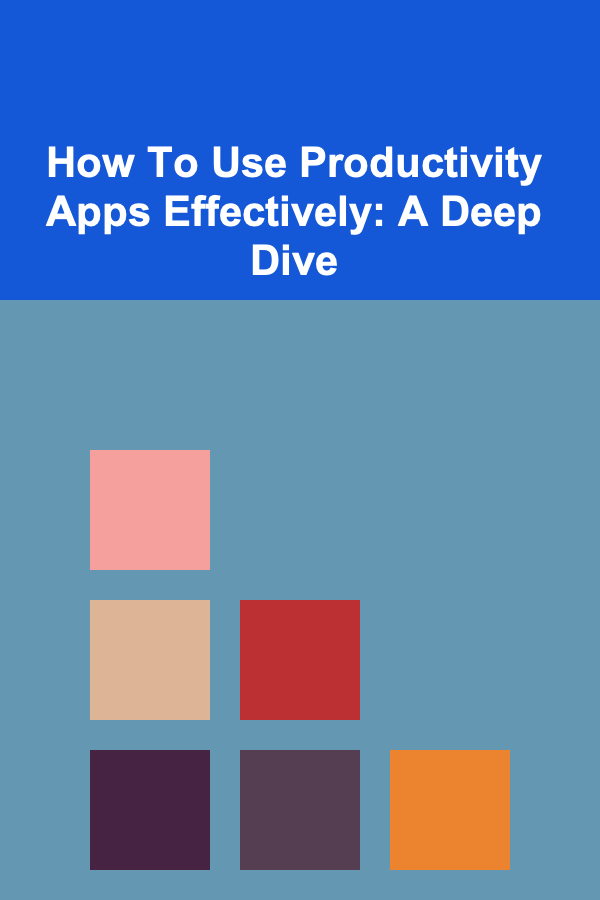
How To Use Productivity Apps Effectively: A Deep Dive
ebook include PDF & Audio bundle (Micro Guide)
$12.99$10.99
Limited Time Offer! Order within the next:

In today's fast-paced world, where we're constantly bombarded with information and demands on our time, productivity has become a highly sought-after skill. Fortunately, a plethora of productivity apps are available to help us manage our tasks, time, and focus. However, simply downloading and installing these apps isn't enough. To truly harness their power, we need to understand how to use them effectively. This article provides a comprehensive guide to maximizing the benefits of productivity apps and achieving our goals.
Understanding the Productivity Landscape
Before diving into specific apps and strategies, it's crucial to understand the broader landscape of productivity. Productivity isn't just about doing more; it's about doing the right things, efficiently and effectively. It's about aligning our actions with our goals and priorities.
Key concepts to consider include:
- Goal Setting: Clearly define your objectives. What do you want to achieve? Without clear goals, productivity efforts are often misdirected.
- Prioritization: Not all tasks are created equal. Learn to identify and focus on the most important tasks that will have the biggest impact. The Eisenhower Matrix (Urgent/Important) is a valuable tool for prioritization.
- Time Management: Allocate your time strategically. Understand how you spend your time, identify time-wasting activities, and schedule your day effectively. Techniques like the Pomodoro Technique can be helpful.
- Focus and Attention: Minimize distractions and create an environment conducive to concentration. Mindfulness techniques and focus-enhancing apps can aid in this area.
- Organization: Keep your workspace (both physical and digital) organized. A cluttered environment can lead to decreased productivity and increased stress.
- Automation: Automate repetitive tasks whenever possible. This frees up your time and mental energy for more important activities.
- Review and Reflection: Regularly review your progress and reflect on what's working and what's not. Adjust your strategies as needed.
Choosing the Right Productivity Apps
The sheer number of productivity apps available can be overwhelming. Choosing the right apps for your needs requires careful consideration. Here's a framework for selecting the best tools:
- Identify Your Needs: What are you struggling with? Are you having trouble managing your tasks, staying focused, or collaborating with others? Identify the specific areas where you need help.
- Research Different Apps: Explore different apps that address your needs. Read reviews, watch demos, and try out free trials. Don't just go with the most popular option; find the app that best fits your workflow and preferences.
- Consider Compatibility: Ensure that the apps you choose are compatible with your devices and operating systems. Look for apps that integrate well with other tools you already use.
- Evaluate Features and Functionality: Pay attention to the features and functionality of each app. Does it offer the features you need, such as task management, calendar integration, note-taking, or collaboration tools?
- Assess the User Interface: The user interface should be intuitive and easy to use. A clunky or confusing interface can hinder your productivity rather than enhance it.
- Consider Pricing: Many productivity apps offer free versions with limited features, as well as paid subscriptions with more advanced functionality. Choose a pricing plan that fits your budget and needs.
- Look for Cross-Platform Availability: If you use multiple devices (e.g., a laptop, smartphone, and tablet), choose apps that are available on all your platforms. This allows you to stay productive wherever you are.
Here are some examples of popular productivity app categories and specific apps within each category:
- Task Management:
- Todoist: A powerful and versatile task management app with features like recurring tasks, subtasks, labels, and filters.
- Asana: A project management tool that's ideal for teams, but also useful for individuals who need to manage complex projects.
- Trello: A visual task management app that uses a Kanban board system. Great for collaborative projects and managing workflows.
- Microsoft To Do: A simple and intuitive task management app that's integrated with Microsoft Outlook.
- Any.do: A sleek and user-friendly task management app with features like location-based reminders and grocery list integration.
- Note-Taking:
- Evernote: A comprehensive note-taking app that allows you to create notes, clip web pages, and store files.
- Notion: An all-in-one workspace that combines note-taking, task management, and database functionality.
- OneNote: A digital notebook that's integrated with Microsoft Office.
- Bear: A beautiful and minimalist note-taking app for Mac and iOS.
- Google Keep: A simple and colorful note-taking app that's integrated with Google Workspace.
- Calendar and Scheduling:
- Google Calendar: A popular and versatile calendar app that's integrated with Google Workspace.
- Microsoft Outlook Calendar: A calendar app that's integrated with Microsoft Outlook.
- Fantastical: A powerful calendar app for Mac and iOS with natural language input.
- Calendly: A scheduling app that allows you to easily schedule meetings with others.
- Doodle: A polling tool for scheduling meetings with multiple people.
- Focus and Productivity:
- Freedom: An app that blocks distracting websites and apps.
- Forest: An app that encourages you to stay focused by planting a virtual tree.
- Serene: A Mac app designed to help you stay in flow and avoid distractions.
- Focus@Will: A music streaming service that's designed to enhance focus and concentration.
- Brain.fm: Another music service utilizing scientifically-backed audio to improve focus.
- Password Management:
- LastPass: A password manager that securely stores your passwords and automatically fills them in when you need them.
- 1Password: Another popular password manager with similar features to LastPass.
- Bitwarden: An open-source password manager.
Mastering the Art of Effective App Usage
Once you've chosen the right apps, the real work begins: learning how to use them effectively. Here are some tips for maximizing the benefits of your productivity apps:
1. Integrate Apps into Your Workflow
Productivity apps are most effective when they're seamlessly integrated into your existing workflow. Don't try to force yourself to use an app in a way that doesn't feel natural. Instead, adapt the app to fit your needs and habits. Experiment with different workflows and see what works best for you.
For example, if you're a visual thinker, you might prefer using Trello's Kanban boards to manage your tasks. If you're more comfortable with lists, Todoist might be a better fit. If you live in the Microsoft ecosystem, using Microsoft To Do will likely be a smoother experience than introducing a third-party app.
2. Customize Apps to Your Specific Needs
Most productivity apps are highly customizable. Take the time to explore the settings and options and tailor the app to your specific needs and preferences. This might involve changing the color scheme, adjusting the notification settings, or creating custom templates.
For instance, in Todoist, you can create custom labels and filters to organize your tasks in a way that makes sense to you. In Notion, you can build entire custom workspaces that cater to your specific workflows, from project management to personal CRM.
3. Establish Consistent Habits
The key to using productivity apps effectively is to establish consistent habits. Set aside time each day to review your tasks, update your calendar, and take notes. Make it a routine, just like brushing your teeth or checking your email. The more consistent you are, the more effective your apps will become.
Consider setting daily, weekly, or monthly routines. For example:
- Daily: Review your task list and calendar for the day first thing in the morning. Update completed tasks and reschedule unfinished ones.
- Weekly: Review your progress against your weekly goals. Plan the upcoming week's tasks and schedule important appointments.
- Monthly: Review your progress against your monthly goals. Reflect on what worked well and what didn't. Adjust your strategies as needed.
4. Master Keyboard Shortcuts
Learning keyboard shortcuts can significantly speed up your workflow and make you more efficient. Most productivity apps have a variety of keyboard shortcuts that allow you to quickly perform common tasks, such as creating a new task, editing a note, or switching between views. Make a conscious effort to learn and use the shortcuts for the apps you use most often. You'll be surprised at how much time you save.
Many apps have a built-in cheat sheet of keyboard shortcuts. Look for it in the app's help menu or settings.
5. Integrate with Other Apps
Many productivity apps integrate with other apps, allowing you to seamlessly transfer data and automate tasks. For example, you can integrate your calendar app with your task management app so that your appointments are automatically added to your task list. Explore the integration options offered by your apps and see how you can streamline your workflow.
Examples of common integrations:
- Task Management & Calendar: Automatically create tasks from calendar events.
- Note-Taking & Task Management: Create tasks directly from your notes.
- Email & Task Management: Turn emails into tasks.
- Password Management & Browsers: Automatically fill in passwords on websites.
6. Use Automation to Your Advantage
Automation can be a powerful tool for boosting productivity. Look for ways to automate repetitive tasks, such as sending emails, creating reports, or backing up your data. Many productivity apps offer built-in automation features, such as Zapier integration, that allow you to connect different apps and automate workflows.
Examples of automation:
- Automatically add new contacts from your email to your CRM.
- Automatically back up your notes to a cloud storage service.
- Automatically post updates to social media when you publish a new blog post.
7. Regularly Review and Refine Your System
Productivity is an ongoing process, not a one-time fix. Regularly review your system and identify areas for improvement. Are there any apps you're not using effectively? Are there any tasks you can automate? Are there any new apps that might be a better fit for your needs? Don't be afraid to experiment and try new things. The key is to find a system that works for you and continuously refine it over time.
Schedule time for a regular review, perhaps weekly or monthly. Ask yourself:
- Am I achieving my goals?
- Am I using my time effectively?
- Are my apps helping me or hindering me?
- Are there any new apps that I should try?
8. Don't Get Distracted by the Shiny Object Syndrome
It's easy to get caught up in the excitement of trying new productivity apps. However, constantly switching between apps can actually be counterproductive. Resist the urge to jump on every new app that comes along. Instead, focus on mastering the apps you already have and using them effectively. Only switch to a new app if you're truly convinced that it will be a significant improvement over your current system.
The "shiny object syndrome" can lead to a lot of wasted time and effort. Stick with the tools that work for you and avoid the temptation to constantly chase the latest and greatest app.
9. Embrace the Power of Habit Stacking
Habit stacking involves linking a new habit to an existing habit. This can be a powerful way to incorporate productivity apps into your daily routine. For example, you could link checking your task management app to your morning coffee routine. Every time you make coffee, you also check your tasks for the day. This makes it more likely that you'll consistently use your app.
Examples of habit stacking:
- After you brush your teeth, check your calendar.
- Before you start working, review your task list.
- After you finish a meeting, add any action items to your task management app.
10. Take Breaks and Avoid Burnout
Productivity isn't about working non-stop. It's about working smarter, not harder. Make sure to take regular breaks throughout the day to rest and recharge. Get up and stretch, go for a walk, or listen to some music. Avoiding burnout is crucial for long-term productivity.
Techniques like the Pomodoro Technique (working in focused bursts with short breaks) can be very effective. Listen to your body and take breaks when you need them. Your productivity will actually increase when you're well-rested and focused.
Common Pitfalls to Avoid
Even with the best apps and strategies, it's easy to fall into common productivity traps. Here are some pitfalls to avoid:
- Over-Reliance on Apps: Don't rely too heavily on apps. They are tools, not solutions in themselves. The fundamentals of time management, prioritization, and focus are still crucial.
- Analysis Paralysis: Spending too much time researching and comparing apps, rather than actually using them. Choose an app and get started!
- Information Overload: Trying to do too much at once. Focus on a few key tasks and avoid multitasking.
- Perfectionism: Striving for perfection can lead to procrastination and decreased productivity. Focus on progress, not perfection.
- Ignoring Feedback: Not regularly reviewing your system and making adjustments based on your experiences.
- Lack of Integration: Using multiple apps that don't work together, creating silos of information and inefficiencies.
- Ignoring Physical and Mental Health: Neglecting sleep, exercise, and healthy eating habits, which are essential for productivity.
The Future of Productivity Apps
The field of productivity apps is constantly evolving. Here are some trends to watch for in the future:
- AI-Powered Productivity: Artificial intelligence is being integrated into productivity apps to automate tasks, provide personalized recommendations, and enhance focus.
- Virtual Reality and Augmented Reality: VR and AR technologies are being used to create immersive and distraction-free work environments.
- Collaboration Tools: Collaboration tools are becoming more sophisticated, allowing teams to work together more effectively, regardless of location.
- Mindfulness and Well-being Apps: There's a growing emphasis on mindfulness and well-being in the workplace, and apps are being developed to help people manage stress, improve focus, and enhance their overall well-being.
- Personalized Productivity: Apps are becoming more personalized, adapting to individual user preferences and needs.
Conclusion
Productivity apps can be incredibly valuable tools for helping us manage our time, tasks, and focus. However, simply downloading and installing these apps isn't enough. To truly harness their power, we need to understand how to use them effectively. This requires choosing the right apps for our needs, integrating them into our workflow, establishing consistent habits, and regularly reviewing and refining our system. By following the tips and strategies outlined in this article, you can unlock the full potential of productivity apps and achieve your goals.
Remember that productivity is a journey, not a destination. It's about continuously learning and improving your strategies and finding what works best for you. Embrace the process, be patient with yourself, and celebrate your successes along the way.
Reading More From Our Other Websites
- [Home Budget 101] How to Plan a Minimalist Home Budget That Focuses on Essentials
- [Home Space Saving 101] How to Use Modular Furniture for Flexible Space Solutions
- [Survival Kit 101] The Best Multi‑Tool Survival Kit for Urban Survivalists Living in Small Studios
- [Home Storage Solution 101] How to Choose the Perfect Storage Ottoman for Your Living Room
- [Mindful Eating Tip 101] Seasonal Mindfulness: Aligning Your Meals with Nature's Rhythms for Sustainability
- [Home Space Saving 101] How to Create a Multi-Functional Living Room That Works for Both Relaxation and Productivity
- [Needle Felting Tip 101] Best Strategies for Monetizing Niche Needle Felting Skills Through Online Workshops and Patreon
- [Home Renovating 101] How to Build a Budget-Friendly Home Renovation Timeline
- [Personal Investment 101] How to Build Wealth with Real Estate Crowdfunding Platforms
- [Survival Kit 101] Top Rated Survival Kits: What Makes Them Stand Out and Why You Need One
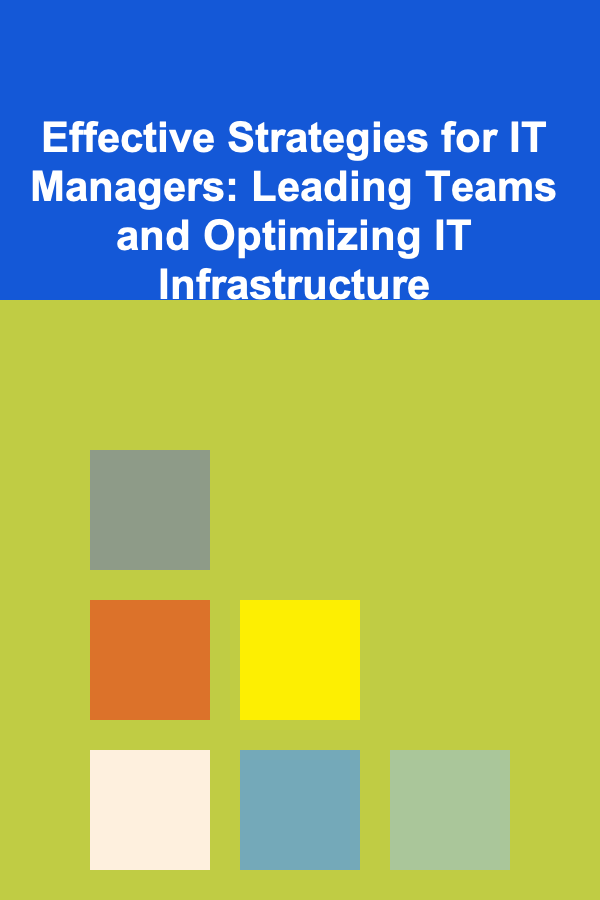
Effective Strategies for IT Managers: Leading Teams and Optimizing IT Infrastructure
Read More
How to Build a Checklist for Identifying Project Risks
Read More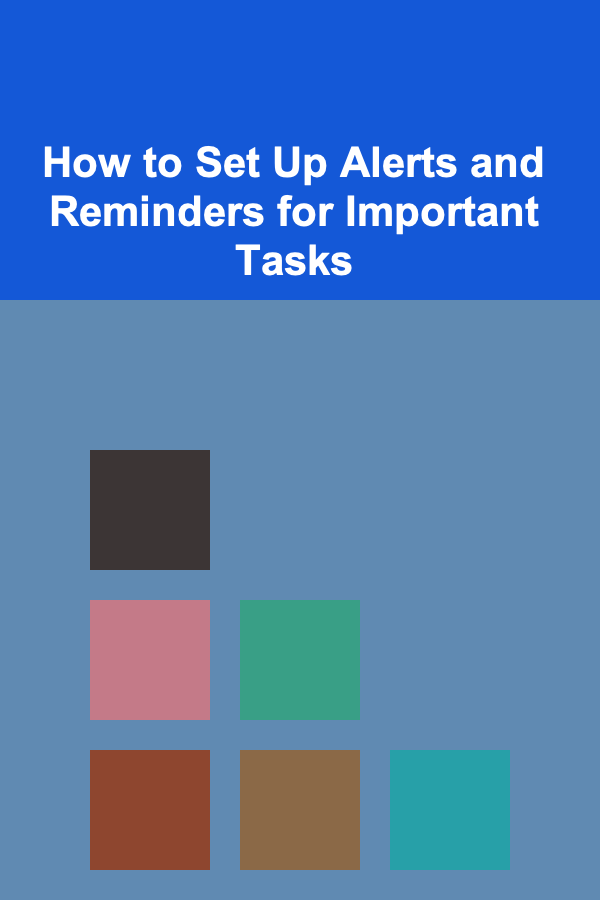
How to Set Up Alerts and Reminders for Important Tasks
Read More
Smart Ways for Saving Money on Extracurricular Activities for Kids
Read More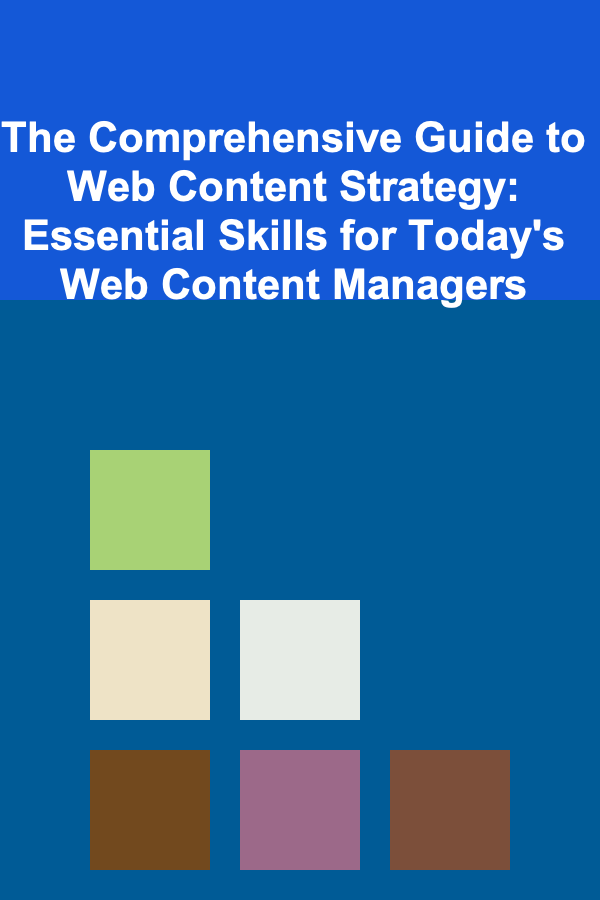
The Comprehensive Guide to Web Content Strategy: Essential Skills for Today's Web Content Managers
Read More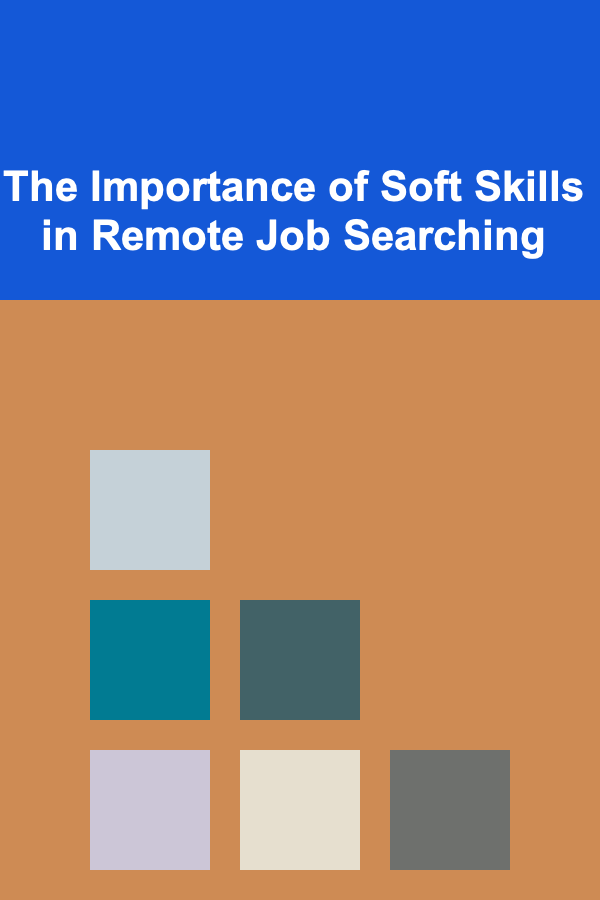
The Importance of Soft Skills in Remote Job Searching
Read MoreOther Products

Effective Strategies for IT Managers: Leading Teams and Optimizing IT Infrastructure
Read More
How to Build a Checklist for Identifying Project Risks
Read More
How to Set Up Alerts and Reminders for Important Tasks
Read More
Smart Ways for Saving Money on Extracurricular Activities for Kids
Read More
The Comprehensive Guide to Web Content Strategy: Essential Skills for Today's Web Content Managers
Read More